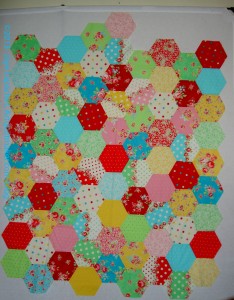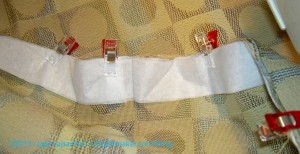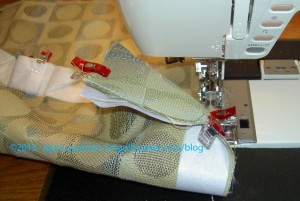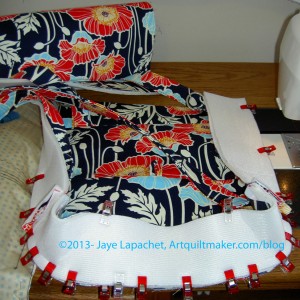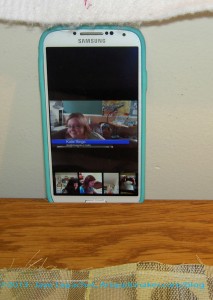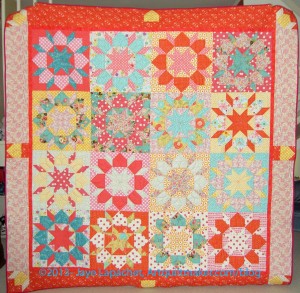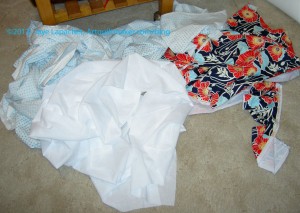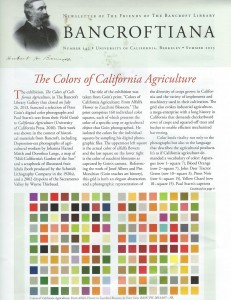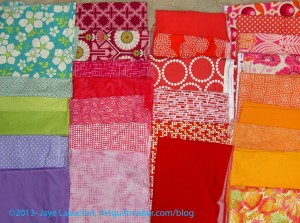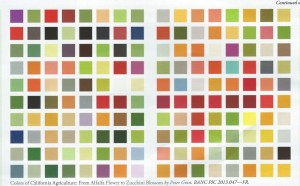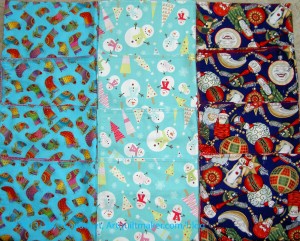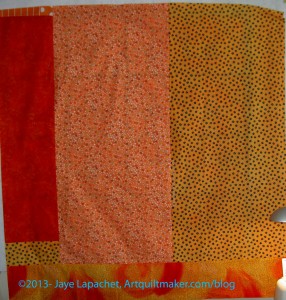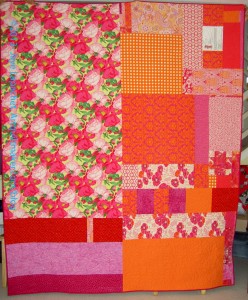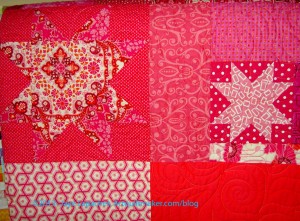I am not 100% happy with this review, but at some point, I just felt I had to post it.
 Modern Quilts from the Blogging Universe by Martingale
Modern Quilts from the Blogging Universe by Martingale
My rating: 2 of 5 stars
I received this book as a gift earlier this year. I have been carrying it around with me and never seemed to get to reading it until a few weeks ago. I was laying on the couch exhausted and picked it up to leaf through while watching TV.
The book is essentially a pattern book with some thoughts by the popular bloggers. The title is a misnomer. The quilts aren’t from the blogging universe, they are from the popular or well known blogging universe. I don’t think it is possible to include all of the quilts from the blogging universe in one book, but the title does suggest that there could be a v.2, v.3, etc.
The introduction is a page long and tries to categorize this book into the modern quilt milieu by defining “modern quilts.” The author writes “In the context of quilts, “modern” doesn’t necessarily mean contemporary. Although the quilts in this book could certainly be categorized as such, this compilation focuses on a specific aesthetic. Designs touch on ideas such as purposeful imperfections; improvisational piecing; exploring negative space and approaching classic quilt blocks in new ways. That said, one rule of modern quiltmaking reigns: there are no rules.”
Sigh.
I really have nothing against modern quilting except that the above implies that this type of quiltmaking has never gone on before. I blame Marketing departments. Everything has to be new and fresh or it is uninteresting, apparently. In the early 1990s there was a dedicated group of art quiltmakers rethinking blocks, doing improvisational piecing and making their own rules. The joy at that time was the same: rebelling against the Quilt Police. The problem at that time was the same: the “no rules mantra” gave people an excuse to do sloppy work. I refuse to even comment on “purposeful imperfections.”
The quilts in this book are not sloppy and, from what I can see, technique is good. I also think it is good to encourage people, regardless of skill level, to make quilts. More quilts are always better. Still, I think there are rules. Not rules about personal aesthetic, but more about quilts shown in books should be at a very high level of technique. What people make for themselves is entirely up to them and NOT what I am talking about.
I also have to say that there is a value in knowing what good design is and is not. It occurs to me that I do not know what the editor means when she says “…one rule of modern quiltmaking reigns: there are no rules.” I think that there are always design rules. Does she mean that a quiltmaker can make one giant block and make that a quilt? If so, I agree and say more power to the quiltmaker.
The introduction mentions social media. I agree that social media is one of the phenomena that helps to define modern quiltmaking (pg.7). Social media, however, is not the exclusive domain of the modern quilters.
Sadly, the editor or compiler, allows incorrect information to be perpetuated. It is particularly bad in this book. For example, “purposeful imperfections” (pg.7) were thought to be something the Amish included in their quilts. The concept was proved to be wrong, because they actually thought that nobody could be perfect except God and they did not need to add an imperfection into a quilt. There would already be imperfections without trying. [Nota bene: Barbara Brackman talks about this: http://barbarabrackman.blogspot.com/2… or http://www.womenfolk.com/historyofqui…. No references, though, I am pretty sure this was discussed in BB’s book Clues in the Calico. There is a detailed commentary here: http://hartcottagequilts.com/his9.htm, which has icons of the quilt history world named as doing research on this topic].
While not everyone believes in God or goes to church regularly, I think it is fair to say that none of us are perfect. I strive to make the best quilt I can. Despite my best efforts, I have blocks that are a hair too small or points that don’t quite match. I have no problem with design choices where points are cut off or Sawtooth Star legs are wonky. Some wonky-improvisational quilts are gorgeous. I don’t think we should blame design choices on the need to make our quilts imperfect. Be inspired by the imperfections of antique and vintage quilts and incorporate them into your design decisions.
The editor/compiler allows some of the essayists to further perpetuate questionable stereotypes. While many quilts were made using leftovers from sewing for the family, many, many quilts were made using especially purchased fabric or kits. Marie Webster, an icon of quiltmaking in the 1910s and 1920s sold these kinds of kits. It is not a good assumption that all quilts were scrap quilts.
As I said, this is essentially a pattern book. I think the book would have been improved with some information about what inspired the bloggers to come up with the designs. I see a lot of questions and comments about how a person thought of a design and not enough of the answers, though I may not be looking in the right places. Giving the answers to the question of what inspires people to make quilts would go far to give others the confidence to make their own designs as well.
The format of the patterns includes a photo, 2-3 pages for the pattern and an essay by the designer. A lot of the designs are derivative, but freshened up with current, fun fabrics.
The first pattern/quilt that caught my attention was Indian Summer (pg. 27), a pointy Dresden Plate. The designer has included some small appliqued circles around the outside of each plate, adding a bit of interest. She also has clear instructions on making those pointy petals by machine.
Knots (pg.33) is a design of interlocking and layered lines. I like the layering of this design, though I would rather see it in brighter colors.
There are two similar quilts in the book, Juicy (pg.15) and Diamond Crosses (pg.50). There are enough differences to make it worth separate patterns, but enough similarities that you may not want to make both.
I really like the movement in Everything’s Coming Up Rainbows (pg.54) and think she gives good directions for easily creating the wonkiness of the blocks. The designer says to use assorted prints in various colors. I think that the success of this quilt’s color palette is that values of the prints she chose are very similar. That is hard to communicate in a book and, perhaps, the designer’s blog gives more information. If not, be sure to chose prints with all clear color OR all prints that have a slightly greyed color to them.
The Rainbow Stashbuster quilt (pg.60) would probably not need as much attention to whether prints were clear or greyed, etc, though some attention to that detail would make this successful.
One of the things I like about this book is the way some of the designers think outside of the box when making the blocks just a little different. Jessica Kovach does this with her Petal Pod (pg.64) quilt. I love the way she added a simple rectangle to a Drunkard’s Path unit (quarter circle and accompanying background) to make a unit that looks like a flower.
Across the Quad (pg.84) is a quilt I might make. I like the balance. While the cross in the bottom part of the quilt is heavier, the small four patch somehow balances it out.
My favorite quilt in this whole book is Candy Necklace (pg.88). Again, there is a suggestion of interlocking piecing. I also like the controlled scrapiness of the fabric selection. The choice of background fabric is key to the success of this piece. I don’t like that some of the necklaces are cut off and would finish them off at the edges and use some background fabric to even up the edge. That is my little quirk, however.
Martingale has done a good thing by including more on topic and putting the basic quiltmaking information on their website. The editor writes “we wanted to offer you as many step by step patterns as we could fit into 96 pages, so we removed our usual section on basic quiltmaking techniques….you can find the info on our website in downloadable form…” (pg.7) Brilliant.
This book is a good start to what I hope is a series that expands beyond the famous ‘modern’ quiltmakers.


